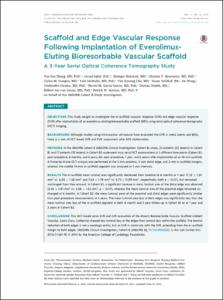KUMEL Repository
1. Journal Papers (연구논문)
1. School of Medicine (의과대학)
Dept. of Internal Medicine (내과학)
Scaffold and Edge Vascular Response Following Implantation of Everolimus-Eluting Bioresorbable Vascular Scaffold A 3-Year Serial Optical Coherence Tomography Study
- Keimyung Author(s)
- Cho, Yun Kyeong
- Department
- Dept. of Internal Medicine (내과학)
- Journal Title
- JACC: Cardiovascular Interventions
- Issued Date
- 2014
- Volume
- 7
- Issue
- 12
- Keyword
- Absorb BVS; bioresorbable scaffold; edge vascular response; in-scaffold vascular response; optical coherence tomography
- Abstract
- Objectives:
This study sought to investigate the in-scaffold vascular response (SVR) and edge vascular response (EVR) after implantation of an everolimus-eluting bioresorbable scaffold (BRS) using serial optical coherence tomography (OCT) imaging.
Background:
Although studies using intravascular ultrasound have evaluated the EVR in metal stents and BRSs, there is a lack of OCT-based SVR and EVR assessment after BRS implantation.
Methods:
In the ABSORB Cohort B (ABSORB Clinical Investigation, Cohort B) study, 23 patients (23 lesions) in Cohort B1 and 17 patients (18 lesions) in Cohort B2 underwent truly serial OCT examinations at 3 different time points (Cohort B1: post-procedure, 6 months, and 2 years; B2: post-procedure, 1 year, and 3 years) after implantation of an 18-mm scaffold. A frame-by-frame OCT analysis was performed at the 5-mm proximal, 5-mm distal edge, and 2-mm in-scaffold margins, whereas the middle 14-mm in-scaffold segment was analyzed at 1-mm intervals.
Results:
The in-scaffold mean luminal area significantly decreased from baseline to 6 months or 1 year (7.22 ± 1.24 mm2 vs. 6.05 ± 1.38 mm2 and 7.64 ± 1.19 mm2 vs. 5.72 ± 0.89 mm2, respectively; both p < 0.01), but remained unchanged from then onward. In Cohort B1, a significant increase in mean luminal area of the distal edge was observed (5.42 ± 1.81 mm2 vs. 5.58 ± 1.53 mm2; p < 0.01), whereas the mean luminal area of the proximal edge remained unchanged at 6 months. In Cohort B2, the mean luminal areas of the proximal and distal edges were significantly smaller than post-procedure measurements at 3 years. The mean luminal area loss at both edges was significantly less than the mean luminal area loss of the in-scaffold segment at both 6-month and 2-year follow-up in Cohort B1 or at 1 year and 3 years in Cohort B2.
Conclusions:
This OCT-based serial EVR and SVR evaluation of the Absorb Bioresorbable Vascular Scaffold (Abbott Vascular, Santa Clara, California) showed less luminal loss at the edges than luminal loss within the scaffold. The luminal reduction of both edges is not a nosologic entity, but an EVR in continuity with the SVR, extending from the in-scaffold margin to both edges.
- Keimyung Author(s)(Kor)
- 조윤경
- Publisher
- School of Medicine
- Citation
- Yao-Jun Zhang et al. (2014). Scaffold and Edge Vascular Response Following Implantation of Everolimus-Eluting Bioresorbable Vascular Scaffold A 3-Year Serial Optical Coherence Tomography Study. JACC: Cardiovascular Interventions, 7(12), 1361–1369. doi: 10.1016/j.jcin.2014.06.025
- Type
- Article
- ISSN
- 1936-8798
- Appears in Collections:
- 1. School of Medicine (의과대학) > Dept. of Internal Medicine (내과학)
- 파일 목록
-
-
Download
 oak-aaa-2645.pdf
기타 데이터 / 1.92 MB / Adobe PDF
oak-aaa-2645.pdf
기타 데이터 / 1.92 MB / Adobe PDF
-
Items in Repository are protected by copyright, with all rights reserved, unless otherwise indicated.